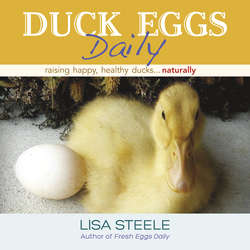Читать книгу Duck Eggs Daily - Lisa Steele - Страница 20
На сайте Литреса книга снята с продажи.
Heat
ОглавлениеA heat lamp is necessary to keep your ducklings warm for the first few weeks. Be sure to position the heat lamp at one end of the brooder so the ducklings can move away if they get too warm. Watch them for cues. If they are huddled under the lamp and peeping loudly, they are cold; if they are panting or clustered at the far side of their brooder area away from the light, then they are too warm.
An EcoGlow brooder is a good, safe choice for brooder heat for the first week or so, but since ducklings grow so fast, they will quickly be too large to fit underneath.
The brooder temperature should be started at 90 degrees F the first day, then lowered by 7 degrees per week (one degree per day) until they are fully feathered and ready to go outside full time – at about 6 weeks old, weather dependent.
An EcoGlo brooder provides heat for young ducklings.
Brooder Temperature Chart
Reduce the temperature one degree per day (shown in Fahrenheit):
1st week 90-84°
2nd week 83-77°
3rd week 76-70°
4th week 69-63°
5th week 62-56°
6th week 55°
At 2-3 weeks old, your ducklings should be able to spend some time outside on warm, sunny days. It’s very important that ducklings get fresh air, sunlight and plenty of exercise, as well as exposure to fresh grass, for healthy development and growth. Of course, this is dependent on your climate – and they need to be protected from predators at all times, including wild birds, crows and snakes.
For spring hatches: at 6-8 weeks old, once your ducklings are fully feathered, they should be ready to move outside and away from the heat permanently – into a dry, draft-free house.
